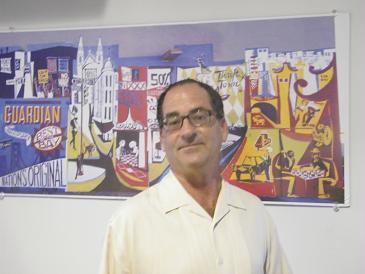WORKING DOGGEDLY TO PIN DOWN THE EDITOR OF THE POTRERO VIEW WHO IS ALSO A CANDIDATE FOR SUPERVISOR FROM DISTRICT 10
We’ve been trying to pin Steve Moss down on some key questions. Over the weekend, I sent him some questions by email. He responded, but ducked or ignored the real points and never gave us any straight answers.
Here’s our exchange, my questions and his answers — unedited, followed by some comments from me as we doggedly try to make sense of where Steve Moss really stands on key issues in the district.
Dear Steve,
In your October, pre-election issue of the Potrero View, your signed column
compares the Guardian with Fox News and states that we are both “advocacy groups disguised as news purveyors” who “whip mostly anonymous commentators on their websites to call political candidates ‘weasle, lying, doucebags’ and worse.” You also state that “these same outlets barely take the time to edit–much less fact check–their stories.”
As you know, our reporter Sarah Phelan has done factual reporting on you and your campaign (http://www.sfbg.com/2010/09/14/five-things-you-should-know-about-steve-moss) and she and I have both checked with you to respond to our points before publication. We will continue our policy by submitting these email questions to you in advance of publication. Our deadline is 5 p.m. on Monday
l. What specific facts do you find inaccurate in our previous reporting on you and your campaign? (You mixed up a comment on a blog with Phelan’s actual story and reporting. Was this intentional?)
2. How much money have you and your various profit and nonprofit enterprises accepted from PG&E during this past year?
How much money have you accepted in total from PG&E during your many years of operating your profit and nonprofit enterprises? Why did you change the pro-public power View of Ruth Passen to a PG&E-friendly View under your ownership? (For example, Passen always supported public power but you as the new owner refused to support the last public power initiative and said it was “too contentious.”)
3. Campaign finance records show that Thomas Coates, a Republican who spent $l million trying to overturn rent control in California in 2008, has just dumped
$45,000 into the so-called Alliance for Jobs and Sustainable Growth in support of your candidacy. Public records also show that you served a cure or quit notice
to a tenant in your rent-controlled building in District 8. Would you comment on this? And would you state whether you support or oppose rent control?
4. On the front page of the October View, your lead story reported on the troubles of the Neighborhood House under the headline, “NABE Reeling Under City Budget Cuts.” Your story noted that the Nabe had lost “nearly $400,000 in funding from the Department of Human Services (DHS) and the Department of Children, Youth and Their Families” and that individual donations had dropped by 75 per cent. The result, your story noted, was that the NABE “has been forced to eliminate teen-focused programming, reduce elementary school offerings by 25 per cent, lay-off staff and impose pay cuts.”
Each year, the NABE sponsors the Potrero Hill festival as a benefit to raise much-needed funds. This year the benefit was more critical than ever to reduce its crippling deficit. Just as the View was going to press earlier this month, I got a call at the Guardian from a representative of the festival with a startling bit of information. I was told that you, as the owner and editor-publisher of the View, and a candidate for supervisor from our district, were refusing to run a full page ad for the festival, a key piece of the NABE’s promotion on the hill,if the ad contained the logo of the Guardian as a festival sponsor.
The representative was concerned that, if you wouldn’t run the NABE ad, that the Guardian as a media sponsor wouldn’t run a NABE ad in the Guardian.
(I told him not to worry, do what he had to do to get the ad in the View, and that the Guardian would run the ad and double up on its promotion for the festival. The Guardian logo did not appear on the Nabe ad in the View but did appear on all other NABE promotions.)
Why did you make this threat to the NABE and its festival benefit? Were you serious?
5. You said in your endorsement interview at the Guardian that, if you were elected supervisor, you would give up the View. Do you still plan to do that, if elected? If so, how would you do that?
Steve Moss responds:
1. The entire way you’ve covered the District 10 election has been slanted towards the candidate you prefer, and against the candidates you dislike. From this perspective the Guardian is not serving the role of a newspaper, but rather is acting as an independent expenditure committee on behalf of its chosen candidates and causes. I’d be happy to select a panel of five independent journalists — you pick two, I’ll pick two, and the four can pick one — to render an opinion about how you’ve run the Guardian during this election cycle, and how I’ve run the View.
2. In 2010 I believe SF Power has received less than $25,000 in payments related to the small business demand-response program it operates, as sanctioned by the California Public Utility Commission. I’ve already provided you and your reporter with multiple responses to your requests about SF Power’s successfull advocacy related to CPUC orders requiring PG&E to fund programs focusing on working families and small businesses, all of which, as I’ve repeatedly pointed out, are a matter of public record.
The View has published several articles about community-based energy systems, and effective ways to achieve local control over the power grid, during my tenure as publisher. They are available on our website.
3. I read about Coats’ contribution in Bay Citizen. As you know, this donation was made to an independent expenditure committee over which I have no control and almost no knowledge. I have stated throughout the campaign, and directly to the Tenants Union, that I believe current rent control policy should remain unmolested.
4. I made no threat to the NABE. In fact, the festival was featured on the front page of the November issue, with a story inside, and a full page ad.
5. Yes. A new editor will be found to run the View if I’m elected to office.
Okay, You aren’t responsive. Let me try again, point by point:
l. I am not running for office. You are. Please tell me where we are factually wrong in any of our reporting on you and your campaign.
As you know, we have contacted you in advance of publication for comment. And you have written us twice with generalities but no specifics on inaccurate reporting.
2. You defend your PG&E payments on the basis that it’s actually money from the California Public Utilities Commission that PG&E is required by law to put up for energy efficiency projects. However, Loretta Lynch, former president of the CPUC, told me that PG&E decides who gets the money and that fund recipients that “cross PG&E” are in danger of getting their funds cut off.
In other words, if you want to continue to fund your organization with upwards of more than $l million over three years, you must avoid angering the utility. This may explain why the Potrero View under your ownership has switched from its historic position supporting public power under former owner Ruth Passen to going easy on PG&E and ducking a position on the most recent public power initiative (Proposition H).
The background: Your non profit collected $1,290,000 from the CPUC for energy efficiency projects over the past three years, according to SF Power’s annual revenues and estimated budgets from 2008 to 2010 as provided on its website.
The breakdown: $500,000 in 2008, $440,000 in 2009, $350,000 in 2010.
You also got $150,000 from the San Francisco Public Utilities Commission in 2008 and $125,000 in 2009. Your non profit also got $50,000 chunks each year from the Richard and Rhoda Goldman fund, where his wife Debbie Findling works. The Lisa and Douglas Goldman Fund kicked in $5,000 in 2008 and 2009. The Potrero View contributed $5,000 in 2008, $4,500 in 2009, and $5,000 in 2010. A footnote stated that SF Power “is also informally negotiating with the California Air Resources Board, San Francisco’s Office of the Mayor, Mirant Corporation, and Pacific Gas and Electric Company, among others, for project funding support.” Did you get any additional money from Mirant, PG&E, the Mayor, or anybody else? Are you still negotiating? If not, when did you stop?
Lynch explained that “all energy efficiency programs in California are funded by ratepayer dollars that are collected by the utilities as part of each ratepayer’s utility bill. Thus, California ratepayers, big and small, pay for all energy efficiency programs and each and every program is funded by ratepayers, not utilities.”
She said that the CPUC “sets broad parameters for each utility concerning the amount of overall energy efficiency savings to be achieved and in what customer classes (residential, small business, large business,etc.). But the utilities choose the program providers. The CPUC simply reviews the overall package provided by the utilities to check to see whether the energy efficiency savings targets are met.”
Thus, PG&E each year decides the amount of money going to SF Community Power. Lynch noted that some non profit people told her, when she was a commissioner, that “if you crossed PG&E, they would stop the funding.”
Lynch mentioned a meeting with you that showed PG&E’s influence on you, your non profit and the View. .
She said that, shortly after she was termed out as a CPUC commissioner in 2009, you asked her to meet with him at Farleys coffee shop and asked her to serve on the board of his nonprofit. “I thanked him and said that he should consider my relationship with PG&E before making that offer if he was funded through PG&E, as PG&E and I have a very contentious relationship, and that they would not be happy if I were on the board. He thanked me for telling him and agreed that I should not serve on the board.” Lynch lives on Potrero Hill.
3. I followed up my rent control question: “If state law were amended to allow it, would you support extending rent control to vacant apartments?” No answer.
4. I got a call from Keith Goldstein, president of the Potrero Hill Association of Merchants and Businesses and co-chair of the festival. He had gotten an email from you that read: “Please have the festival’s pr agent remove the Guardian’s logo from any complimentary ad the View is providing the festival in this month’s paper.” Why did you make such an unprofessional move? Would you have backed out of sponsoring this event if the Guardian logo had remained? Is that how you would behave as a supervisor?
5. If elected, do you plan to sell the View? Will you continue to operate your non profit and take chunks of money from PG&E? If elected, would your income from PG&E disquality you from voting on PG&E and energy issues? At what point would you sever your relations, if at all, with your non profit and PG&E?
6. If you lose, will you (as your wife suggested in an email to friends) move back to your house on Liberty St in Distict 8?
We anxiously await your response. B3




